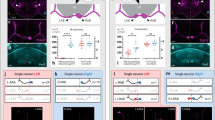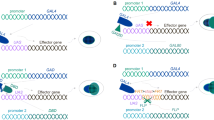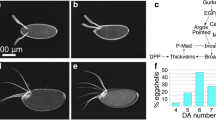Abstract
The sbr gene is an ortholog of evolutionarily conservative nxf1 (nuclear export factor) genes that control nuclear-cytoplasmic transport of mRNA in various eukaryotic organisms. Mutations of sbr exhibit a broad range of pleiotropic effects, which are characteristic of “housekeeping” genes. Certain allele-specific manifestations of the sbr gene in neurogenesis and behavior facilitate a deeper understanding of not only universal but also highly specialized functions of this gene. Among such characteristic features of adult males with an sbr12 mutation are reduced locomotor activity as revealed in the negative geotaxis test and significant morphological disruptions of the ellipsoid body and the medulla, both of which are important for locomotion. The character of defects in the ellipsoid body and the medulla suggests that the SBR protein is essential for the normal formation and functioning of these nerve centers, and that the protein carries not only universal but also specialized functions.
Similar content being viewed by others
References
Herold, A., Klymenko, T., and Izaurralde, E., NXF1/p15 heterodimers are essential for mRNA nuclear export in Drosophila, RNA, 2001, vol. 7, pp. 1768–1780.
Wilkie, G.S., Zimyanin, V., Kirby, R., et al., small bristles, the Drosophila ortholog of NXF-1, is essential for mRNA export throughout development, RNA, 2001, vol. 7, pp. 1781–1792.
Tretyakova, I.V., Lyozin, G.T., Markova, E.G., et al., The sbr gene product in Drosophila melanogaster and its orthologs in yeast (Mex67p) and human (TAP), Russ. J. Genet., 2001, vol. 37, no. 6, pp. 593–602.
Katahira, J., Dimitrova, L., Imai, Y., and Hurt, E., NTF2-like domain of Tap plays a critical role in cargo mRNA recognition and export, Nucleic Acids Res., 2015, vol. 43, pp. 1894–1904. doi 10.1093/nar/gkv039
Atsapkina, A.A., Golubkova, E.V., Kasatkina, V.V., et al., Peculiarities of spermatogenesis in Drosophila melanogaster: role of main transport receptor of mRNA (Dm NXF1), Cell Tissue Biol., 2010, vol. 4, no. 5, pp. 429–435.
Golubkova, E.V., Atsapkina, A.A., and Mamon, L.A., The role of sbr/Dm nxf1 gene in syncytial development in Drosophila melanogaster, Cell Tissue Biol., 2015, vol. 9, no. 4, pp. 271–283. doi 10.1134/S1990519X15040057
Yakimova, A.O., Pugacheva, O.M., Golubkova, E.V., and Mamon, L.A., Cytoplasmic localization of SBR (Dm NXF1) protein and its zonal distribution in the ganglia of Drosophila melanogaster larvae, Inver. Neuro., 2016, vol. 9. doi 10.1007/s10158-016-0192-5
Zhimulev, I.F., Belayeva, E.S., Pokholkova, G.V., et al., Report of new mutants, Dros. Inf. Serv., 1981, vol. 56, pp. 192–196.
Feany, M.B. and Bender, W.W., A Drosophila model of Parkinson’s disease, Nature, 2000, vol. 404, pp. 394–398. doi 10.108/5006074
Ali, Y.O., Escala, W., Ruan, K., and Zhai, R.G., Assaying locomotor, learning, and memory deficits in Drosophila models of neurodegeneration, J. Vis. Exp., 2011, vol. 49. e2504. doi 10.3791/2504
Nichols, C.D., Becnel, J., and Pandey, U.B., Methods to assay Drosophila behavior, J. Vis. Exp., 2012, vol. 61. e3795. doi 10.3791/3795
Barone, M.C. and Bohmann, D., Assessing neurodegenerative phenotypes in Drosophila dopaminergic neurons by climbing assays and whole brain immunostaining, J. Vis. Exp., 2013, vol. 74. e50339. doi 10.3791/50339
Ashburner, M., Drosophila: A Laboratory Handbook and Manual, in two volumes, New York: Cold Spring Harbor Lab., 1989.
Strauss, R., The central complex and the genetic dissection of locomotor behaviour, Curr. Opin. Neurobiol., 2002, vol. 12, pp. 633–638. doi 10.1016/S0959-4388(02)00385-9
Morante, J., Erclik, T., and Desplan, C., Cell migration in Drosophila optic lobe neurons is controlled by eyeless/Pax6, Development, 2011, vol. 138, pp. 687–693. doi 10.1242/dev.056069
Borst, A., Haag, J., and Reiff, D.F., Fly motion vision, Annu. Rev. Neurosci., 2010, vol. 33, pp. 49–70.
Takemura, S.Y., Bharioke, A., Lu, Z., et al., A visual motion detection circuit suggested by Drosophila connectomics, Nature, 2013, vol. 500, pp. 175–181. doi 10.1038/nature12450
Takemura, S.-Y., Connectome of the fly visual circuitry, Microscopy, 2015, vol. 64, pp. 37–44. doi 10.1093/jmicro/dfu102
Young, J.M. and Armstrong, J.D., Structure of the adult central complex in Drosophila: organization of distinct neuronal subsets, J. Comp. Neurol., 2010, vol. 518, no. 9, pp. 1500–1524. doi 10.1002/cne.22284
Boquet, I., Boujemaa, R., Carlier, M.-F., and Préat, T., Ciboulot regulates actin assembly during Drosophila brain metamorphosis, Cell, 2000, vol. 102, pp. 797–808.
Boquet, I., Hitier, R., Dumas, M., et al., Central brain postembryonic development in Drosophila: implication of genes expressed at the interhemispheric junction, J. Neurobiol., 2000, vol. 42, pp. 33–48. doi 10.1002/(SICI)1097-4695(200001)42:1<33::AID-NEU4> 3.0.CO;2-T
Ohler, S., Hakeda-Suzuki, S., and Suzuki, T., Hts, the Drosophila homologue of adducin, physically interacts with the transmembrane receptor golden goal to guide photoreceptor axons, Dev. Dyn., 2011, vol. 240, pp. 135–148. doi 10.1002/dvdy.22515
Popov, A.V., Peresleni, A.I., Ozerskii, P.V., et al., The role of the flabellar and ellipsoid bodies of the central complex of the brain of Drosophila melanogaster in the control of courtship behavior and communicative sound production in males, Neurosci. Behav. Physiol., 2005, vol. 35, no. 7, pp. 741–750. doi 10.1007/s11055-005-0118-x
Sakai, T. and Kitamoto, T., Differential roles of two major brain structures, mushroom bodies and central complex, for Drosophila male courtship behavior, J. Neurobiol., 2006, vol. 66, pp. 821–834. doi 10.1002/neu.20262
Edwards, T.N. and Meinertzhagen, I.A., The functional organization of glia in the adult brain of Drosophila and other insects, Prog. Neurobiol., 2010, vol. 90, no. 4, pp. 471–497. doi 10.1016/j.pneurobio.2010.01.001
Bausenwein, B. and Fischbach, K.F., Activity labeling patterns in the medulla of Drosophila melanogaster caused by motion stimuli, Cell Tissue Res., 1992, vol. 270, pp. 25–35.
Melnattur, K.V. and Lee, C.-H., Visual circuit assembly in Drosophila, Dev. Neurobiol., 2011, vol. 71, pp. 1286–1296. doi 10.1002/dneu.20894
Takemura, S.Y., Lu, Z., and Meinertzhagen, I.A., Synaptic circuits of the Drosophila optic lobe: the input terminals to the medulla, J. Comp. Neurol., 2008, vol. 509, pp. 493–513.
Takemura, S.Y., Xu, C.S., Lu, Z., et al., Synaptic circuits and their variations within different columns in the visual system of Drosophila, Proc. Natl. Acad. Sci. U.S.A., 2015, vol. 112, pp. 13711–13716. doi 10.1073/pnas.1509820112
Egger, B., Boone, J.Q., Stevens, N.R., et al., Regulation of spindle orientation and neural stem cell fate in the Drosophila optic lobe, Neural Develop., 2007, vol. 2, p. 1. doi 10.1186/1749-8104-2-1
Ilius, M., Wolf, R., and Heisenberg, M., The central complex of Drosophila melanogaster is involved in flight control: studies on mutants and mosaics of the gene ellipsoid body open, J. Neurogenet., 1994, vol. 9, pp. 189–206.
Martín-Peña, A., Acebes, A., Rodríguez, J.-R., et al., Cell types and coincident synapses in the ellipsoid body of Drosophila, Eur. J. Neurosci., 2014, vol. 39, pp. 1586–1601. doi 10.1111/ejn/12537
Wu, C.L., Xia, S., Fu, T.F., et al., Specific requirement of NMDA receptors for long-term memory consolidation in Drosophila ellipsoid body, Nat. Neurosci., 2007, vol. 10, pp. 1578–1586. doi 10.1038/nn2005
Neuser, K., Triphan, T., Mronz, M., et al., Analysis of a spatial orientation memory in Drosophila, Nature, 2008, vol. 453, pp. 1244–1247. doi 10.108/nature07003
Pan, Y., Zhou, Y., Guo, C., et al., Differential roles of the fan-shaped body and the ellipsoid body in Drosophila visual pattern memory, Learn. Mem., 2009, vol. 16, pp. 289–295. doi 10.1101/lm.13311809
Hanesch, U., Fischbach, K.F., and Heisenberg, M., Neural architecture of the central complex in Drosophila melanogaster, Cell Tissue Res., 1989, vol. 457, pp. 343–366.
Renn, S.C.P., Armstrong, J.D., Yang, M., et al., Genetic analysis of the Drosophila ellipsoid body neuropil: organization and development of the central complex, J. Neurobiol., 1999, vol. 41, pp. 189–207.
Yang, J.S., Awasaki, T., Yu, H.H., et al., Diverse neuronal lineages make stereotyped contributions to the Drosophila locomotor control center, the central complex, J. Comp. Neurol., 2013, vol. 521, pp. 2645–2662. doi 10.1002/cne.23339
Mamon, L.A., Ginanova, V.R., Kliver, S.F., et al., RNA-binding proteins of the NXF (nuclear export factor) family and their connection with the cytoskeleton, Cytoskeleton, 2017, vol. 74, pp. 161–169. doi 10.1002/cm.21362
Golubkova, E.V., Nokkala, S., and Mamon, L.A., The nuclear export factor gene small bristles is involved in the control of early embryonic mitoses in Drosophila melanogaster, Drosophila Inf. Serv., 2006, vol. 89, pp. 31–39.
Yoon, D.W., Lee, H., Seol, W., et al., Tap: a novel protein that interacts with tip of herpesvirus saimiri and induces lymphocyte aggregation, Immunity, 1997, vol. 6, pp. 571–582.
Herold, A., Suyama, M., Rodrigues, J.P., et al., TAP (NXF1) belongs to a multigene family of putative RNA export factors with a conserved modular architecture, Mol. Cell. Biol., 2000, vol. 20, no. 23, pp. 8996–9008.
Jin, L., Guzik, B.W., Bor, Y., et al., Tap and NXT promote translation of unspliced mRNA, Genes Devel., 2003, vol. 17, pp. 3075–3086. doi 10.1101/gad.1155703
Ivankova, N., Tretyakova, I., Lyozin, G., et al., Alternative transcripts expressed by small bristles, the Drosophila melanogaster nxf1 gene, Gene, 2010, vol. 458, pp. 11–19. doi 10.1016/j.gene.2010.02.013
Ginanova, V., Golubkova, E., Kliver, S., et al., Testisspecific products of the Drosophila melanogaster sbr gene, encoding nuclear export factor 1, are necessary for male fertility, Gene, 2016, vol. 577, pp. 153–160. doi 10.1016/j.gene.2015.11.030
Herold, A., Teixeira, L., and Izaurralde, E., Genomewide analysis of nuclear mRNA export pathways in Drosophila, EMBO J., 2003, vol. 22, pp. 2472–2483. doi 10.1093/emboj/cdg233
Huang, Y., Gattoni, R., Stévenin, J., et al. SR splicing factors serve as adapter proteins for TAP-dependent mRNA export, Mol. Cell., 2003, vol. 11, pp. 837–843.
Saito, K., Fujiwara, T., Katahira, J., et al., TAP/NXF1, the primary mRNA export receptor, specifically interacts with a neuronal RNA-binding protein HuD, Biochem. Biophys. Res. Commun., 2004, vol. 321, pp. 291–297. doi 10.1016/j.bbrc.2004.06.140
Hautbergue, G.M., Huang, M.-L., Golovanov, A.P., et al., Mutually exclusive interactions drive handover of mRNA from export adaptors to TAP, Proc. Natl. Acad. Sci. U.S.A., 2008, vol. 105, pp. 5154–5159. doi 10.1073/pnas.0709167105
Walsh, M., Hautbergue, G.M., and Wilson, S.A., Structure and function of mRNA export adaptors, Biochem. Soc. Trans., 2010, vol. 38, pp. 232–236. doi 10.1042/BST0380232
Yamazaki, T., Fujiwara, N., Yukinaga, H., et al., The closely related RNA helicases, UAP56 and URH49, preferentially form distinct mRNA export machineries and coordinately regulate mitotic progression, Mol. Biol. Cell, 2010, vol. 21, pp. 2953–2965. doi 10.1091/mbc.E09-10-0913
Viphakone, N., Cumberbatch, M.G., Livingstone, M.J., et al., Luzp4 defines a new mRNA export pathway in cancer cells, Nucleic Acids Res., 2015, vol. 43, pp. 2353–2366. doi 10.1093/nar/gkv070
Kopytova, D., Popova, V., Kurshakova, M., et al., ORC interacts with THSC/TREX-2 and its subunits promote Nxf1 association with mRNP and mRNA export in Drosophila, Nucleic Acids Res., 2016, vol. 44, pp. 4920–4933. doi 10.1093/nar/gkw192
Müller-McNicoll, M., Botti, V., de Jesus Domingues, A.M., et al., SR proteins are NXF1 adaptors that link alternative RNA processing to mRNA export, Genes Dev., 2016, vol. 30, pp. 553–566. doi 10.1101/gad.276477.115
Golubkova, E.V., Markova, E.G., Markov, A.V., et al., Dm nxf1/sbr gene affects the formation of meiotic spindle in female Drosophila melanogaster, Chromosome Res., 2009, vol. 17, pp. 833–845. doi 10.1007/s10577-009-9046-x
Katahira, J., Straßer, K., Podtelejnikov, A., et al., The Mex67p mediated nuclear mRNA export pathway is conserved from yeast to human, EMBO J., 1999, vol. 18, pp. 2593–2609.
Viphakone, N., Hautbergue, G.M., Walsh, M., et al., TREX exposes the RNA binding domain of Nxf1 to enable mRNA export, Nat. Commun., 2012, vol. 3, p. 1006. doi 10.1038/ncomms2005
Author information
Authors and Affiliations
Corresponding author
Additional information
Original Russian Text © A.O. Yakimova, E.V. Golubkova, S.V. Sarantseva, L.A. Mamon, 2018, published in Genetika, 2018, Vol. 54, No. 6, pp. 603–612.
Rights and permissions
About this article
Cite this article
Yakimova, A.O., Golubkova, E.V., Sarantseva, S.V. et al. Ellipsoid Body and Medulla Defects and Locomotion Disturbances in sbr (small bristles) Mutants of Drosophila melanogaster. Russ J Genet 54, 609–617 (2018). https://doi.org/10.1134/S1022795418060145
Received:
Accepted:
Published:
Issue Date:
DOI: https://doi.org/10.1134/S1022795418060145




